|
http://www.sppw1944.org/index.html?http://www.sppw1944.org/pamiec/pecice_eng.html

Stowarzyszenie
Pamięci
Powstania
Warszawskiego
1944
The first day of the Warsaw Uprising in the 4th AK
District Ochota did not bring the expected results. Despite the
heroic efforts of Polish soldiers, the blatant disproportion
between the number of insurgents and military and police units of
the German occupier made it impossible to take over some strategic
points in the city. The attack launched on Dom Akademicki (the
Dormitory), located on
Narutowicza St.,
ended in failure. Heavy casualties sustained by the insurgents
were its only consequences. The only modest success scored by the
Polish combatants was capturing the House of the Sons of Divine
Providence at 4 Barska St., garrisoned by the supply unit of
German panzer division "Hermann Goering". However, no matter how
much valor the insurgents had demonstrated on the battlefield,
they were eventually forced to retreat from all other locations in
Warsaw. Lacking in weapons and ammunition, they suffered heavy
losses.
In the face of such a difficult situation, Lt. Col.
Mieczyslaw Sokolowski "Grzymala", the commander of the 4th
District Ochota of the Home Army, called the meeting at the night
of 1 and 2 August. There, he made a dramatic decision to withdraw
all forces from the capital. The insurgents were to retreat and
take shelter in the forests near
Warsaw
and return to the city later, after rearming with supplies from
the expected air drops. The retreating forces were to make their
way towards Sekocinski Forest, and later towards Chojnowski
Forest.
This decision, made in dramatic circumstances by Lt.
Col. Mieczyslaw Sokolowski "Grzymala", had one purpose: to lead
the remaining forces out of the city and into the forests, as
their further stay in Warsaw without weapons and ammunition was
totally unproductive. After rearming, the insurgents were to make
their way back to the city, at the time and place optimal from
both operational and tactical points of view.
The decision was taken by "Grzymala" at 1.00 am on 2
August. As early as 2.00 am, under cover of a cloudy, rainy night,
the units began to set off at the gates of ZUS buildings located
at 7/9 Niemcewicza St. The group consisted of approximately 700
insurgents and civilians, who were mostly poorly armed. The column
began to advance along Niemcewicza and Szczesliwicka St., heading
towards Reguly village.
The head of the column was made up of about 50 soldiers
forming an advance party. They belonged to 404 and 406 platoons
from the group of 2nd Lt. Tadeusz Korecki "Kalina", under the
command of 2nd Lt. Kazimierz Jaczewski "Brzask". On the previous
day, i.e. 1 August, these combatants captured the buildings of the
approved school at 4 Barska St., garrisoned by about 50 German
soldiers. The advance party was followed by the advance guard,
formed by 100 soldiers led by Cpt. Lucjan Dybaczewski "Korwin",
the second-in-command of the 1st Region's commanding officer.
The advance guard preceded the main column commanded by
Lt. Col. Sokolowski. It comprised about 500 insurgents and
civilians, both groups practically unarmed. There were also
several dozen women from medical service. The column left the city
without greater obstacles, making its way through Szczesliwice
(where they engaged a German police station and captured a light
machine gun) to Salomea, where they were joined by soldiers from
"Odwet" Battalion under the command of Lt. Witold Daab "Stefan".
Lt. "Stefan" had not received the information about the
concentration and departure of the troops on time, hence his
delay.
By means of the Electrical Suburban Railway (WKD) the
column was transported to Reguly village, which was about 5 km
from Salomea (the Railway had to run three times to transport all
of the soldiers). There, the column was regrouped. Lt. Col.
Sokolowski released the civilians, ordering them to spread out.
Heavy wounded soldiers were left in the care of Jerzy Zapasiewicz
pseudonym "Uczony", the officer in the Bureau of Information and
Propaganda of the 4th District. In this way the column was reduced
by about 100 people.
After regrouping, the column continued its way towards
Pecice. Some time later the insurgents reached a crossroad: one
route led in the direction of Pruszkow, the other towards Pecice
village. Facing the crossroad there was the manor house in Pecina,
surrounded by the park. The farm buildings could be seen on its
right side, while on the left side the house bordered the
neighboring village. Several dozen enemy soldiers of 19th Panzer
Division with radio station were quartered inside the manor. In
addition, a certain number of Wehrmacht soldiers were staying in
the village.
The distance between Reguly and Pecice was about 2 km.
But the lay of the land was unfavorable from the operational point
of view: First the insurgents had to cover about 1 km of a country
road that led along the hillside towards Pecice. The next leg of
the journey included about 1 km of a dyke running along a wide
water-meadow. The relief of the terrain made it easy for the enemy
to detect any of the approaching Polish units and open fire on
them.
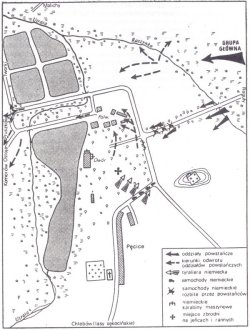
The
progress of the battle of Pecice
No sooner had the insurgents reached the dyke
about 200 m from the park, than there appeared three German
vehicles (an off-road vehicle and two trucks), following the
wooded road along the border of the park. They were coming from
Pecice direction. The insurgents attacked immediately and, thanks
to their quick reaction, the danger was soon neutralized. A few of
German soldiers were killed on the spot, but the rest of them,
including an officer, took to flight. Apart from the vehicles, the
insurgents acquired a number of German weapons.
But the noise of the fight alarmed the Germans stationed
in the village and the manor house. As a result, before the
advance party could collect all the weapons left by the enemy and
withdraw, the Germans quickly took up the positions along the
border of the park and set up at least two machine guns ready to
fire. At the same time, Wehrmacht forces from Pecice formed a line
formation and sent a few cars equipped with heavy machine guns to
a nearby hill - the location of an old military cemetery dating
back to World War I period. This enabled them to open fire on the
flank of the insurgents' troops.
When the machine guns located near the park began their
cannonade, the advance party of the column, led by 2nd Lt.
Kazimierz Jaczewski "Brzask", got down on the ground. However, it
was just a moment later when Cpt. Lucjan Dobaczewski "Korwin", the
leader of the advance guard, stood up again and, like an ordinary
soldier with a rifle in his hand, bravely advanced on the enemy,
setting the example for the rest of the first line of insurgents
to follow. The Poles mounted an assault. The first to attack was
the advance party, made up of 50 soldiers, followed by the advance
guard with 100 combatants. This unit consisted of the bravest
people with the best weapons in all of District Ochota. Among them
were three scout platoons: the platoon commanded by Officer Cadet
Iwon Rygiel "Boguslaw", recently incorporated into GS "Zoska"
Scout Platoon, the covering platoon of the commander-in-chief of
the AK District, and the communication platoon. The insurgents
from the left flank successfully destroyed the German machine gun
post.
The frontal groups of the column clashed with German
troops in a short but bloody fight. The skirmish took place on the
way to the park and on its premises, and again, as before on the
streets of District Ochota, it was the Germans who dominated over
the insurgents due to their technical advantage and superior
position. Soon there came additional vehicles from the village,
and the German infantry charged. The scouts were able to reach the
border of the park, where they encountered the German soldiers
advancing in line. The insurgents' attack launched on the manor
house also broke down. The squad commanded by Officer Cadet Bohdan
Szermer "Lwowicz" pelted the German line with grenades, silencing
them effectively, but the Poles paid for this victory with the
loss of several scouts. The zone of attack was soon covered with
31 combatants' bodies, mostly scouts who died there at a very
young age. There were also 30 injured soldiers on the insurgents'
side. On the other hand, the Germans lost 20 soldiers (including
who had died in the previous attack launched on German vehicles),
plus an unspecified number of wounded Germans.
After the unsuccessful attack on the manor house, the
advance guard started to retreat to the north. They planned to
cross the bridge between the lake and fish ponds, and then turn
back to
Sekocinski Forest lying in the south.
The main part of the column was about 600 m behind the
advance guard. On hearing the shooting, the insurgents rushed to
the north and crossed the meadow, the river and a narrow isthmus
in an effort to steer clear of the German positions. The group
consisted of two sub-units, led by Cpt. Tadeusz Jasinski "Zych"
and Lt. Witold Daab "Stefan". When the frontal troops started
their attack on the enemy, the main part of the column began its
turning movement around the enemy positions by following the road
situated to the north of the manor house and the farm. The route
led across the bridge on the Utrata river and through the dyke
between Pecice ponds. Although the direction of the maneuver was
expedient, it nonetheless forced the unprotected group to make its
way along a 200-meter path covered by the German machine gun.
The majority of the group, led by Lt. "Stefan", quickly
ran across the dangerous field; the second group followed Cpt.
"Zych" and went north in the direction of Malichy village. Soon
the panic began to reap its harvest among the ranks of the Polish
troops - they began to lose hope due to the scarcity of weapons
and ammunition. They also still remembered the defeat suffered on
the streets of Ochota district. Although the enemy's fire, led
from a distance of several hundred meters, was not very effective,
a lot of insurgents lost their strength and perseverance needed to
strike through the enemy line and move away from the hazardous
area. Instead, they threw themselves to the ground, seeking cover
behind stacks of new-mown barley and rye, trying to hide in the
furrows on the potato field or among the bushes in the park. In
most cases, however, this shelter proved to be tragically
illusive.
Those troops that were able to force their way
northwards (about 300 soldiers, part of them lightly injured)
continued their strenuous march to Chlebowski Forest under the
command of Lt. Col. Sokolowski. Having reached their destination,
"Grzymala" regrouped the troops and formed two companies: "Korwin"
- under the command of Cpt. Dobaczewski and "Stefan" - commanded
by Lt. Daab. In the small hours of 3 August the insurgents
threaded their way through Sekocinski Forest and reached
Chojnowski Forest.
Over the next two weeks the Polish regiment was busy
regrouping and rearming. At the night of 18 and 19 August the
insurgents set out for Warsaw to help liberate the city from the
German occupation. One of the bloodiest battles between the
insurgents and the enemy took place in the vicinity of Wolica and
Wilanowo, when the Polish combatants attempted to break through
the German siege south of
Warsaw.
One of the soldiers killed in action was Lt. Col. Mieczyslaw
Sokolowski "Grzymala", the commander of the regiment, previously
in charge of the 4th AK District Ochota. Nonetheless, the majority
of the regiment penetrated through the German ring of siege and
reached Mokotow, where they took part in further fights for
Warsaw.
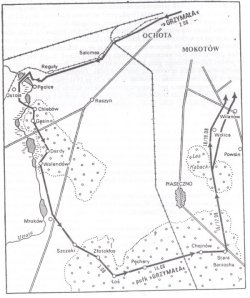
The
route of the regiment commanded by Lt. Col. "Grzymala"
Most of the insurgents who remained on the
battlefield near Pecice village met a fate worse than death. The
German reinforcements stationed in the vicinity of the battle,
alarmed by means of phone or radio, quickly arrived at the scene.
Among them was the SS regiment from Pruszkow, accompanied by two
tanks and a surveillance aircraft. The Germans launched a raid
against the remaining Polish forces - they captured about 80
insurgents as a result. The interrogation of the prisoners-of-war
was led by SS officers and it lasted all day. As was the manner of
SS, the questioning was combined with beating and abuse, and not
one wounded soldier was spared. In the end, on 2 August 1944 about
6 pm, the Nazi tormentors executed 60 captured insurgents,
including injured soldiers, and 5 women. However, 7 POWs were
saved thanks to the intercession of one of injured German
officers. In addition to this, about 20 people, mainly women, were
spared their lives and set free by one of non-commissioned
Wehrmacht officers (a Silesian). He did it probably at his own
responsibility, without other SS officers' knowledge. Moreover, a
few of the captives were able to get away from the hands of their
torturers. This escape was successful thanks to the favorable
weather. Under cover of night and rain, the captives were able to
break free, their escape not noticed by the German enemy. Such was
the second phase of Pecice's tragedy.
After the execution, the Germans forced local
inhabitants to dig a pit in the park, the size of 3x4 m and 2 m in
depth. The corpses of executed and fallen soldiers where then
gathered together and thrown into the hole. After that the
collective tomb was filled. To sum up, there were about 91 Polish
people altogether who were either killed in action or murdered
near Pecice village. The heaviest losses were suffered by the
scout platoons of "Zoska" Battalion and the platoons of 4th
District. 40 victims were below the age of 20, with the youngest
of them being just 14.
In April 1946 the bodies of the insurgents fallen or
murdered in the Battle of Pecice were exhumed. There were 89
corpses excavated from the tomb. The missing bodies of two other
insurgents had been found in the field by the inhabitants of the
village a few days after the battle and had then been buried at
the local cemetery. During the exhumation process, 51 victims were
identified. The identities of another 21 insurgents were
established at a later date, but 19 soldiers remained unknown.
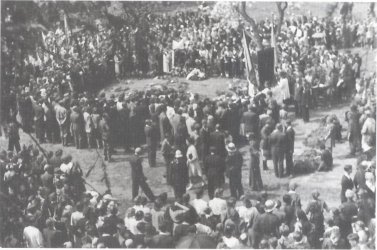
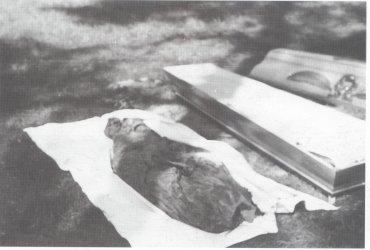
The
exhumation of insurgents performed in 1946
The list of soldiers killed in the Battle of Pecice:
1. Zbigniew Chrzanowski "Wilk" aged 14
2. Michal Aleksander Dowbor "Zbyszek" " aged 15
3. Zbigniew Matecki " aged 15
4. Wojciech Wajszczuk " aged 15
5. Wacław Janusz Zawadzki " aged 15
6. Tadeusz Dudek "Gryf" aged 16
7. Ireneusz Kolodziejczak "Irena" aged 16
8. Kazimierz Graba-Lecki "Kazik" aged 16
9. Ireneusz Mej aged 16
10. Tadeusz Pietraszkiewicz "Soplica" aged 16
11.
Wieslaw Andrzej Radtke "Wiesiek" aged 16
12. Wojciech Reszczycki "Jerzy" aged 16
13. Wieslaw Zareba-Rychwalski "Orzel" aged 16
14. Zbigniew Urbanek "Tadek" aged 16
15. Bogdan Antoni Bednarczyk "Bogdaniec" aged 17
16. Zygmunt Dworak "Marysia" aged 17
17. Franciszek Napiecek "Franek" aged 17
18. Jerzy Ostrowski aged 17
19. Kazimierz Dabrowski "Witold" aged 18
20. Jozef Jodlowski "Lechita" aged 18
21. Piotr Karczewski "Tomek" aged 18
22. Janusz Antoni Kubisz "Antoni" aged 18
23. Waldemar Lukas "Lukasz" aged 18
24. Wieslaw Olszewski "Wiesiek" aged 18
25. Tadeusz Osinski "Warszawiak" aged 18
26. Henryk Tolak "Kaczan" aged 18
27. Antoni Wazynski "Stefan" aged 18
28. Zbigniew Ryszard Arendarczyk "Zajaczek" aged 19
29. Jan Bednarek "Kisieleska" aged 19
30. Marian Czujkowski aged 19
31. Ryszard Dudek "Jowisz" aged 19
32. Ryszard Grzegorzewski aged 19
33. Ryszard Janiszewski "Maly" aged 19
34. Wladyslaw Kokot aged 19
35. Zenon Antoni Kotynski aged 19
36. Marian Nieweglowski aged 19
37. Tadeusz Wladyslaw Podolski "Rosomak" aged 19
38. Boguslaw Polkowski "Kozak" aged 19
39. Jerzy Rowinski "Rybowicz" aged 19
40. Stanislaw Konrad Reszczyk "Baska" aged 19
41. Wieslaw Skudlarski "Benito" aged 19
42. Janusz Edward Wojewodzki "Mruczek" aged 19
43. Janusz Euzebiusz Zwolinski "Karp" aged 19
44. Henryk Kozubek "Grom" aged 20
45. Janusz Rudnicki-Boleszczyc "Orzel" aged 20
46. Piotr Zambrowski "Piotrus" aged 20
47. Tadeusz Borkowski "Winkiel" aged 21
48. Stanislaw Mozer "Wichrowski" aged 21
49. Janusz Paderewski "Boruta" aged 21
50. Kazimierz Popek aged 21
51. Wladyslaw Skowron aged 21
52. Wojciech Haas "Bocian" aged 22
53. Maria Piotrowiczowna "Zonia" aged 22 woman
54. Aleksander Kornatowski "Aleksander" aged 23
55. Kazimierz Majewski aged 23
56. Stefan Marian Ostrowski "Ciupaga" aged 23
57. Iwo Rygiel "Boguslaw" aged 23br> 58. Ryszard Sikorski aged 23
59. Lech Wojciech Polachowski "Romuald Blaszczak" aged 24
60. Jan Konowrocki aged 25
61. Henryk Tadeusz Mikolajski "Tadeusz" aged 25
62. Czesław Wlasinski "Czermak" aged 25
63. Zenon Krzeminski aged 27
64. Jozef Kwiatek "Robak" aged 32
65. Marian Napieraj aged 32
66. Anna Krystyna Murzecka "Hanka", "Walka" aged 35 woman
67. Kazimierz Kubasiewicz "Jaskolka" aged 36
68. Jozef Bazylewicz "Kamienny" aged 38
69. Leon Rose aged 52
70. Eugeniusz Muszynski "Michał"
71. Tadeusz Studzinski "Bystry"
72. Wanda - a nurse
73-91. 19 unknown soldiers.
In memory of the fallen soldiers, a
monument-mausoleum was erected near the collective tomb in the
Pęcice park. It was raised thanks to the money from the families
and the society, including a special donation given by Col.
"Radoslaw" (Jan Mazurkiewicz), President of the Home Army
Liquidation Committee. The construction of the monument, designed
by the architect Eng. Piasecki, ended in August 1946.
Its builders included:
Eng. Jozef Sommer - builder;
Cychowski - sculptor;
Lopienscy Brothers - prepared a cast bronze eagle;
Master Jagodzinski;
Waclaw Sadowski
Henryk Poplawski - stonemasons.
The Monument Construction Committee included the
following parents of the fallen soldiers:
Waclaw Kornatowski -
Warsaw;
Eugeniusz Arendarczyk;
Bronislaw Bednarek;
Kazimierz Chrzanowski -
Warsaw;
Wanda Ryglowa Zofia Kwiatkowska - Warsaw;
Jan Sadowski - Piastow;
and a representative of the Home Army Liquidation Committee (Cpt.
"Suzin").
The Pęcice Tomb is the unique place among the Polish
necropolises due to the fact that the bodies rest in the same
place where the victims lost their lives. The names of 67 fallen
soldiers who had been identified were inscribed in the memorial
plaque. The tomb is crowned with an eagle with his wings
outspread: it keeps watch over the peace and tranquility of the
fallen insurgents. Even in the darkest hour of the Stalinist
period the eagle kept its Jagiellonian crown.
The groundbreaking plaque of the monument says: "In
eternal honor of the fallen Warsaw Insurgents, the Soldiers of the
Home Army, the Scouts of the Grey Ranks (Szare Szeregi) from
Warsaw and its precincts, and in eternal honor of the future
generations of the Polish Nation, in the place that turned out to
be the tomb and one of many places of massacre, this monument has
been erected, funded by the parents and the society."
It is thanks to the efforts of Gmina Michalowice that
for many years the Monument-Mausoleum has been kept in an
excellent condition, for which it is known in Warsaw. In
Michalowice's budget there are special funds reserved for
maintaining and conserving the greenery and flowers and for the
preservation of the monument.
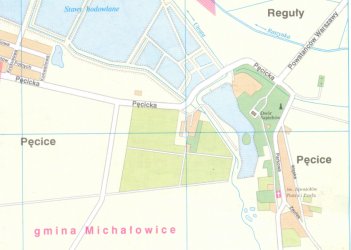
The
situation map of the region at present
The annual celebrations of the Battle of Pecice
and the Rally called "On the stony road" have become traditional
features of this region. On Sunday preceding the anniversary of
the Warsaw Uprising's outbreak, near the Monument-Mausoleum in
Pecice there takes place a ceremonial assembly in honor of the
fallen insurgents. Also the ending of the Rally "On the stony
road" is organized at that time. The events have been taking place
since 1967 continuously. The purpose of the Rally and other
festivities is to pay tribute to the fallen and murdered soldiers
of the Home Army and to remember the ideals for which they
sacrificed their lives.
The idea of the Rally arose as a result of the
cooperation between the parents of the soldiers who lost their
lives in the Battle of Pecice and the group of enthusiasts from
the PTTK VARSOVIA Club, founded in 1966. Mr. Eugeniusz
Arendarczyk, father of "Zajaczek", one of the soldiers killed in
Pecice, and Mrs. Krystyna Serwaczak, the then vice-President of
the Club, came to the conclusion, the righteousness of which they
convinced others, that the annual ceremony of the families and
comrades-in-arms gathering around the memorial would be propagated
better and receive more publicity if combined with a tourist event
organized under the auspices of PTTK. The authorities of that time
did not raise any objections to such a formula of the event,
although they were generally unwilling towards any patriotic
events that had not received an official stamp.
The name of the Rally "On the stony road" refers to the
road Reguly - Pecice, which was at that time made of stone. It is
also a symbolic reference to the fate of the former insurgents.
The first Rally of 1967 was a big success. It gathered
about 400 tourists swarming on the hiking routes and motor tracks,
while the ceremony at the memorial attracted 1500 attendants.
The following years witnessed even more participants.
What is equally important, the youth also became interested in
these events.

An
event poster advertising XLI Rally
In 2007, on the 63rd anniversary of the battle of
Pęcice, there took place already XLI Rally "On the stony road",
organized by the Varsovia Club of the Polish Tourist Country
Lovers' Society.
The Rally would not take place without the help of the
following people:
Jan Glura - chairman of the Local Society of War Veterans;
Roman Lawrance - village-mayor of Michałowice;
Wlodzimierz Majdewicz - designer of most of the commemorative
rally stamps, co-organizer and long-term commander of the Rally;
Wojciech Marcinkiewicz - chairman of the Home Army Soldiers
Society of IV District Ochota;
Tadeusz Martusewicz - director of the Aleksander Janowski Warsaw
Department of PTTK;
Jerzy Pamrow - director of Varsovia Club, co-organizer of the
Rally and the events;
Krystyna Serwaczak - long-term director of the Varsovia Club,
originator of the Rally and co-organizer of the festivities and
tourist events. The woman-institution, whose name is associated
with the Battle of Pęcice;
Kazimierz Wroniszewski - historian; author of the book "IV Obwod
AK Ochota - Okręg Warszawa" (IV District Ochota - Warsaw Area);
Tadeusz Zieliński - Home Army soldier of the Scout Battalion
"Zoska", fought in the Battle of Pęcice.
Below you will find the photo coverage of the 63rd
anniversary of Pęcice Battle.
|